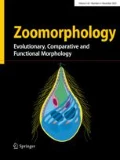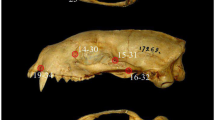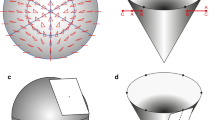Abstract
Geometric morphometric studies are increasingly becoming common in systematics and palaeontology. The samples in such studies are often small, due to the paucity of material available for analysis. However, very few studies have tried to assess the impact of sampling error on analytical results. Here, this issue is addressed empirically using repeated randomized selection experiments to build progressively smaller samples from an original dataset of ∼400 vervet monkey (Cercopithecus aethiops) skulls. Size and shape parameters (including mean size and shape, size and shape variances, angles of allometric trajectories) that are commonly used in geometric morphometric studies, are estimated first in the original sample and then in the random subsamples. Estimates are then compared to give an indication of what is the minimum desirable sample size for each parameter. Mean size, standard deviation of size and variance of shape are found to be fairly accurate even in relatively small samples. In contrast, mean shapes and angles between static allometric trajectories are strongly affected by sampling error. If confirmed in other groups, our findings may have substantial implications for studies of morphological variation in present and fossil species. By performing rarefaction analyses like those presented in our study, morphometricians can be easily provided with important clues on how a simple but crucial factor like sample size can alter results of their studies.



Similar content being viewed by others
References
Adams DC, Slice DE, Rohlf FJ (2004) Geometric morphometrics: ten years of progress following the ‘revolution’. Ital J Zool 71:5–16
Bookstein FL (1991) Morphometric tools for landmark data. Cambridge University Press, Cambridge, MA
Bruner E, Manzi G, Arsuaga JL (2003) Encephalization and allometric trajectories in the genus Homo: evidence from the Neandertal and modern lineages. Proc Natl Acad Sci USA 100:15335–15340
Cardini A (2003) The geometry of marmot (Rodentia: Sciuridae) mandible: phylogeny and patterns of morphological evolution. Syst Biol 52:186–205
Cardini A, Thorington RW Jr (2006) Post-natal ontogeny of the marmot (Rodentia, Sciuridae) cranium: allometric trajectories and species divergence. J Mammal 87:201–216
Cardini A, Thorington RW Jr, Polly PD (2007a) Evolutionary acceleration in the most endangered mammal of Canada: phylogenetic signal and cranial divergence in the Vancouver Island marmot (Rodentia, Sciuridae). J Evol Biol (in press). doi:10.1111/j.1420-9101.2007.01398.x
Cardini A, Jansson A-U, Elton S (2007b) Ecomorphology of vervet monkeys: a geometric morphometric approach to the study of clinal variation. J Biogeogr (in press). doi:10.1111/j.1365-2699.2007.01731.x
Caumul R, Polly PD (2005) Phylogenetic and environmental components of morphological variation: skull, mandible and molar shape in marmots (Marmota, Rodentia). Evolution 59:2460–2472
Collard M, O’Higgins P (2001) Ontogeny and homoplasy in the papionin monkey face. Evol Dev 3:322–331
Cobb SN, O’Higgins P (2004) Hominins do not share a common postnatal facial ontogenetic shape trajectory. J Exp Zool B 302:302–321
Delson E, Harvati K, Reddy D, Marcus LF, Mowbray K, Sawyer GJ, Jacob T, Márquez S (2001) The Sambungmacan 3 Homo erectus calvaria: a comparative morphometric and morphological analysis. Anat Rec 262:360–377
Dobigny G, Baylac M, Denys C (2002) Geometric morphometrics, neural networks and diagnosis of sibling Taterillus (Rodentia, Gerbillinae) species. Biol J Linn Soc 77:319–327
Dryden IL, Mardia KV (1993) Multivariate shape analysis. Sankhya 55(A):460–480
Dryden IL, Mardia KV (1998) Statistical shape analysis. Wiley, New York
Foote M (1997) The evolution of morphological diversity. Ann Rev Ecol Syst 28:129–152
Frost SR, Marcus LF, Bookstein FL, Reddy DP, Delson E (2003) Cranial allometry, phylogeography,and systematics of large-bodied papionins (primates: cercopithecinae) inferred from geometric morphometric analysis of landmark data. Anat Rec 275A:1048–1072
Harvati K (2003) Quantitative analysis of Neanderthal temporal bone morphology using 3-D geometric morphometrics. Am J Phys Anthropol 120:323–338
Klingenberg CP, Monteiro LR (2005) Distances and directions in multidimensional shape spaces: implications for morphometric applications. Syst Biol 54:678–688
Leigh SR (2006) Cranial ontogeny of Papio baboons (Papio hamadryas). Am J Phys Anthropol 130:71–84
Milne N, O’Higgins P (2002) Inter-specific variation in Macropus crania: form, function and phylogeny. J Zool 256:523–535
Mitteroecker P, Gunz P, Bernhard M, Schaefer K, Bookstein FL (2004) Comparison of cranial ontogenetic trajectories among great apes and humans. J Hum Evol 46:679–697
Nicola PA, Monteiro LR, Pessoa LM, Von Zuben FJ, Rohlf FJ, Dos Reis SF (2003) Congruence of hierarchical, localized variation in cranial shape and molecular phylogenetic structure in spiny rats, genus Trinomys (Rodentia: Echimyidae). Biol J Linn Soc 80:385–396
O’Higgins P (1999) Ontogeny and phylogeny: morphometric approaches to the study of skeletal growth and evolution. In: Chaplain MAJ, Singh GD, McLachlan J (eds) On growth and form: Spatio-temporal patterning in biology. Wiley, New York, pp 373–393
O’Higgins P, Jones N (2006) Morphologika 2.2. Tools for shape analysis. Hull York Medical School, University of York, York. Http://www.york.ac.uk/res/fme/
Pan R, Wei F, Li M (2003) Craniofacial variation of the Chinese macaques explored with Morphologika. J Morphol 256:342–348
Penin X, Berge C, Baylac M (2002) Ontogenetic study of the skull in modern humans and common chimpanzees: neotenic hypothesis reconsidered with a tridimensional Procrustes analysis. Am J Phys Anthropol 118:50–62
Polly PD (2005) Development and phenotyopic correlations: the evolution of tooth shape in Sorex araneus. Evol Dev 7:29–41
Polly PD Phylogeographic differentiation in Sorex araneus: is the species morphologically homogenous? Russian Ther J (in press)
Ponce de León MS, Zollikofer CPE (2001) Neanderthal cranial ontogeny and its implications for late hominid diversity. Nature 412:534–538
Rohlf FJ (1998) On applications of geometric morphometrics to study of ontogeny and phylogeny. Syst Biol 47:147–158
Rohlf FJ (2000a) On the use of shape spaces to compare morphometric methods. Hystrix It J Mamm 11:8–24
Rohlf FJ (2000b) Statistical power comparisons among alternative morphometric methods. Am J Phys Anthropol 111:463–478
Rohlf FJ (2003a) Bias and error in estimates of mean shape in morphometrics. J f Evol 44:665–683
Rohlf FJ (2003b) TpsSmall. Department of Ecology and Evolution, State University of New York, Stony Brook, New York. Http://life.bio.sunysb.edu/morph/
Rohlf FJ (2005) NTSYS-pc, version 2.20d. Exeter Software, Setauket, New York
Rohlf FJ, Marcus LF (1993) A revolution in morphometrics. Trends Ecol Evol 8:129–132
Rohlf FJ, Slice DE (1990) Extensions of the Procrustes method for the optimal superimposition of landmarks. Syst Zool 39:40–59
Rohlf FJ, Loy A, Corti M (1996) Morphometric analysis of old world Talpidae (Mammalia, Insectivora) using partial-warp scores. Syst Biol 45:344–362
Singleton M (2002) Patterns of cranial shape variation in the Papionini (Primates: Cercopithecinae). J Hum Evol 42:547–578
Singleton M (2005) Craniofacial shape variation in cercopithecine primates. In: Slice D (ed) Modern morphometrics in physical anthropology. Kluwer, New York, pp 313–347
Slice DE (1999) Morpheus, beta version. Department of Ecology and Evolution, State University of New York, Stony Brook, New York
Slice DE (2005) Modern morphometrics. In: Slice D (ed) Modern morphometrics in physical anthropology. Kluwer, New York, pp 1–45
SPSS for Windows (2004) SPSS Inc., Version 11.5.0 SPSS Inc., Chicago, IL, USA
Tosi AJ, Detwiler KM, Disotell TR (2005) X-chromosomal window into the evolutionary history of the guenons (Primates: Cercopithecini). Mol Phylogenet Evol 36:58–66
Zelditch ML, Swiderski DL, Sheets HD, Fink WL (2004) Geometric morphometrics for biologists: a primer. Elsevier Academic, Amsterdam
Acknowledgments
We are greatly in debt to all museum curators and collection managers who gave us permission to study the specimens in their care and helped during data collection. A large number of people have contributed in different ways to this study. We are deeply grateful to all of them, and apologize to those whom we might have forgotten to acknowledge. Special thanks are due to P. O’Higgins, University of York; F. J. Rohlf, State University of New York; C. P. Klingenberg, University of Manchester, Manchester; P. D. Polly, Indiana University, Bloomington. We also very much appreciate the comments of an anonymous referee and the Editor in improving this work, and thank them for their time and trouble. This study was funded by a grant from the Leverhulme Trust.
Author information
Authors and Affiliations
Corresponding author
Rights and permissions
About this article
Cite this article
Cardini, A., Elton, S. Sample size and sampling error in geometric morphometric studies of size and shape. Zoomorphology 126, 121–134 (2007). https://doi.org/10.1007/s00435-007-0036-2
Received:
Accepted:
Published:
Issue Date:
DOI: https://doi.org/10.1007/s00435-007-0036-2




